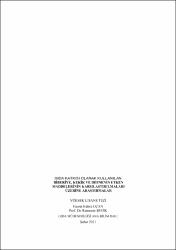Gıda Katkısı Olarak Kullanılan Biberiye, Kekik Ve Defnenin Etken Maddelerinin Karşılaştırılmaları Üzerine Araştırmalar
Abstract
Bu çalışmada, süperkritik karbondioksit (SC-CO2) ve distilasyon yöntemleriyle ekstrakte edilen kekik (Thymus vulgaris L.), biberiye (Rosmarinus officinalis L.) ve defne (Laurus nobilis L.) uçucu yağların kimyasal bileşimi belirlenmiştir. SC-CO2 ekstraktsiyon yöntemiyle elde edilen kekik, biberiye ve defne uçucu yağlarında sırasıyla %14.565, %4.134 ve %2.755 linalool tespit edilirken, aynı bitki yağlarında sırasıyla %37.057, %2.942 ve % 2.742 karvakrol teşhis edilmiştir. Distilasyon yöntemiyle elde edilen kekik uçucu yağı %3.589 linalool, %72.160 karvakrol, %1.626 borneol ve % 1.920 timol içerirken, biberiye uçucu yağı %3.331 linalool, %10.449 1,8-sineol, %11.224 kamfor, % 6.669 borneol ve %0.207 timol içermiştir. Her iki yöntemle elde edilen kekik uçucu yağın dominant bileşeni karvakrol iken, biberiye ve defne uçucu yağının ise 1,8-sineol olmuştur. In this study, the chemical composition of thyme (Thymus vulgaris L.), rosemary (Rosmarinus officinalis L.) and laurel (Laurus nobilis L.) essential oils extracted by supercritical carbon dioxide (SC-CO2) and distillation methods were determined. While 14.565%, 4.134% and 2.755% linalool were detected in thyme, rosemary and laurel essential oils obtained by SC-CO2 extraction method, respectively, 37.057%, 2.942% and 2.742% carvacrol were detected in the same plant oils, respectively. While thyme essential oil obtained by the distillation method contains 3.589% linalool, 72.160% carvacrol, 1.626% borneol and 1.920% thymol, rosemary essential oil contained 3.331% linalool, 10.449% 1,8-cineol, 11.224% camphor, 6.669% borneol and 0.207% thymol. While the dominant component of thyme essential oil obtained by both methods was carvacrol, the major constituent of rosemary and laurel essential oils was 1,8-cineol.
Collections
- Yüksek Lisans Tezleri [890]



















